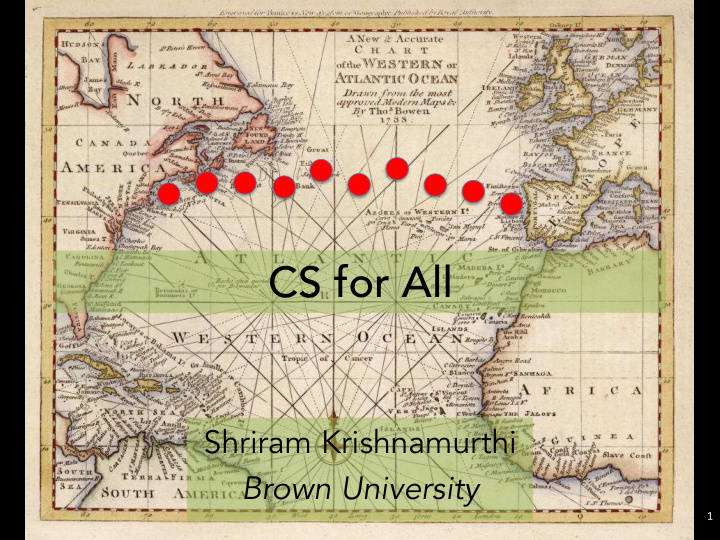



CS for All Shriram Krishnamurthi Brown University 1
There are about 3,000 more! Most aren’t research universities There are also over 1,500 2-year collleges 2
Coding Academies (“Hacker Schools”) Urban Feeder/Non-Feeder Competitive/ Non-Competitive MOOCs For-profit/ Non-profit Rural Private Public 3
D ESIGN ESIGN F F ORCES ORCES 4
Social science Science Engineering Everyone Feeder Business High-school credit 5
C OMPUTING OMPUTING FOR FOR A LL LL 6
Urban Non-Feeder Competitive ~32,000 applicants (Harvard: ~39,000 Princeton: ~27,000 Yale: ~29,000) Private 7
Brown CS CS is the #1 major at Brown 25% bigger than next biggest major Approximately 12% of university Without sacrificing rigor! About 40% to Google; MS, Fb, … 8
What About the Rest? Several strategies for rest of campus Easy way: Make it (meet) a requirement Hard way: Everything else! 9
Bootstrap: Computational Modeling in Algebra, Physics, and Data Science for all students One of the largest CS outreach programs Part of White House’s CS4All program 10
C URRICULUM URRICULUM D D ESIGN ESIGN IS IS AN AN E NGINEERING NGINEERING P P ROBLEM ROBLEM What are your design constraints? 11
Race Gender SES Diversity 1 Gen … Scale Rigor 12
Diversity Scale Rigor 13
Diversity Scale Rigor 14
Diversity Scale Rigor 15
Brown CS Bootstrap Incorporate into required school courses (Algebra, Social Studies, Science) with measured transfer 16
Three month-long projects Problems taken from target subjects A month of Excel! Final output is a report, not program 17
SIGCSE 2018 Tutorial Saturday 2-5pm From Spreadsheets to Programs: Reconciling Data Science and CS1 Politz, Fisler, Krishnamurthi, Lerner 18
T HE HE I I MMA TURITY OF OF CS E CS E D MMATURITY Where is the science for curriculum engineering? 19
Diction Our diction is still stuck with languages “We teach Java” “We teach Python” Not always necessary; certainly not sufficient 20
Principles vs. Platforms A computing platform (Arduino, drone, …): • represents itself • represents something bigger than itself Failing to articulate learning objectives means we conflate them (and skip the latter) 21
Continuity Later classes don’t pick up on earlier ones How many of your faculty really know what is taught in the intro class? How many care? Early faculty don’t want to know what is in later classes “Let me teach Haskell and leave me alone!” 22
New Challenges Where are • embedded computing • distributed computing • data science? Each has fundamentally new requirements Can’t just keep doing for loops (or objects) 23
Pressure from Below Students increasingly come to college with quite sophisticated backgrounds Need to remove them from the general student pool Worse, words ≠ knowledge 24
Pushing Downward What is your CS-in-schools initiative? Do you treat it as more than a hobby? What are its design criteria? (Diversity, rigor, scale?) 25
Plagiarism A problem from a certification perspective It’s really a mechanism design problem Our successful approach so far: Peer review 26
Running in Place Enrollment challenges means • no time to innovate • no need to attract new students • resources are spread thin • student quality is variable • difficult to maintain authenticity yet the opportunities are greater than ever 27
Recommend
More recommend